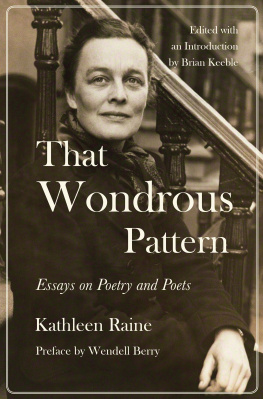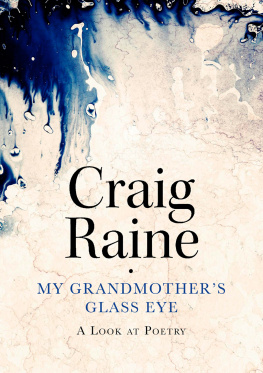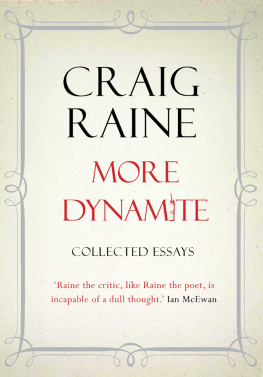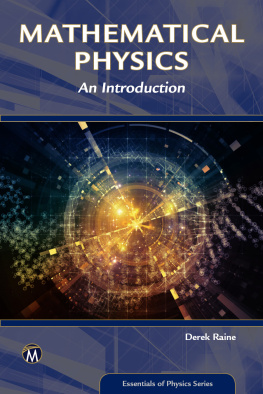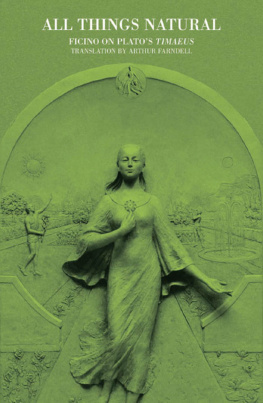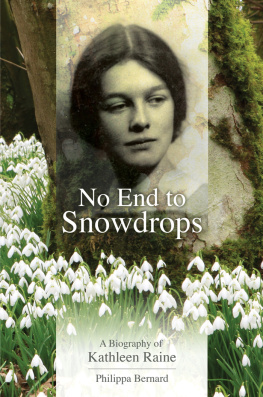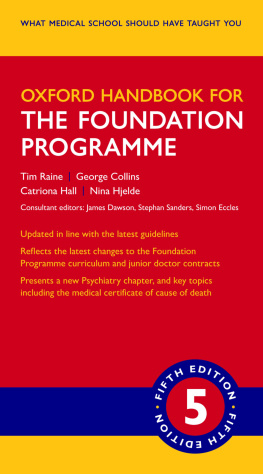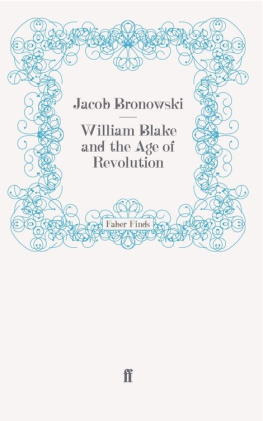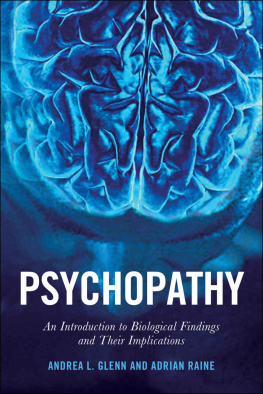
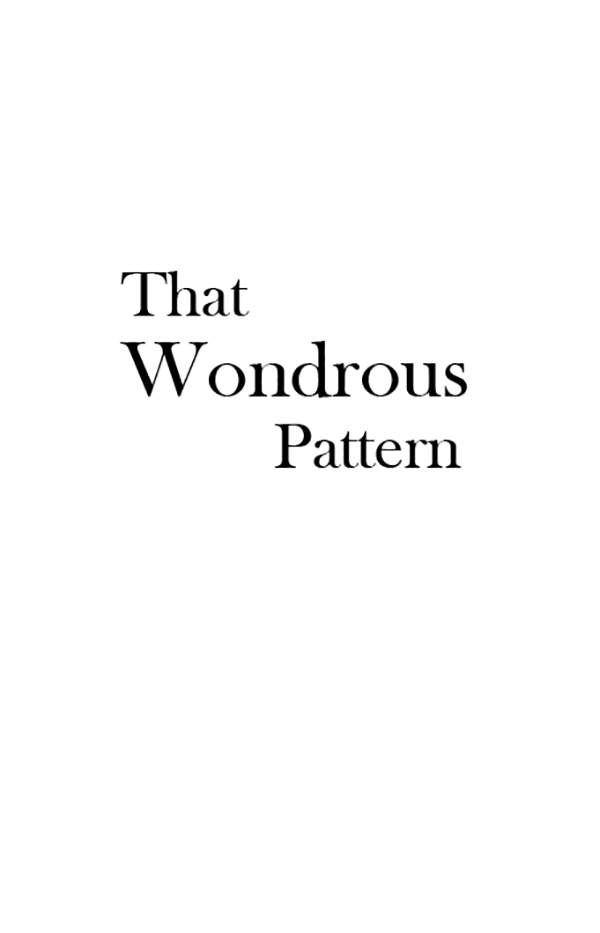

C opyright 2017 by The Literary Estate of Kathleen Raine
Preface 2017 by Wendell Berry
All rights reserved under International and Pan-American Copyright Conventions. No part of this book may be used or reproduced in any manner whatsoever without written permission from the publisher, except in the case of brief quotations embodied in critical articles and reviews.
Library of Congress Cataloging-in-Publication Data Is Available.
Jacket design by Kelly Winton
Book design by Megan Jones Design
eISBN 978-1-61902-987-3
COUNTERPOINT
2560 Ninth Street, Suite 318
Berkeley, CA 94710
www.counterpointpress.com
Printed in the United States of America
Distributed by Publishers Group West
10 9 8 7 6 5 4 3 2 1
CONTENTS
I:
THE PRESENCE OF POETRY
II:
THE WISDOM OF POETRY
III:
THE WITNESS OF POETRY
PREFACE
F or a long time, our world has been dominated by a scientifichence economic and politicalmaterialism, which knows that all of reality can be, and finally will be, explained by physics. A theory of everything, a truth of the universe, will finally be derived from the observation of parts and particles. And this has involved a paradox increasingly obvious and fearful: the material world, which ought logically to be cherished by materialists, has instead by their influence and their processes been wasted, deformed, poisoned, and made ugly.
This has been accepted, even abetted, by a conventional religious dualism that involves another cruel paradox: many Christians and Christian sects, which ought logically to cherish this world as the approved work of God and thus as a good gift and a privilege, regard it instead as a trap or prison from which the soul must escape by repudiating its earthly life and accepting a formula for salvation. This sort of spirituality is little more than materialisms second face, for it abandons the world and our economic life in it to the materialists.
This curious alliance is opposed, and perhaps is opposable only, by the vision of the completeness of reality that is said to underlie the traditional cultures and religions of the world. This visionattested by scholars and authorities far more learned than I am, though certainly confirmed by my own experience and readingsees the outer world as continuous with and dependent upon inner realities such as love, reverence, goodness, and beauty. These realities, though they have belonged always to the actual lives of most people, the materialists dismiss as intangible and therefore unreal. The religious dualists see them perhaps as real enough, while, like the materialists, seeing them also as irrelevant to the natural life and human economy of this world.
The consequent estrangement of body and soul, Heaven and Earth, time and eternity, leading to the further estrangements of utility and beauty, work and pleasure, and all the rest of the divisions and divorces of our mechanical civilization, is owing to the loss of the ancient unifying vision by which we have been enabled to see in the world the eternal light that everywhere informs it. This vision, this immemorial knowledge and way of knowing, survives only marginally in the modern world. Inherently opposed as it is to the radical simplifications of the materialist explainers and devisers, it is assuredly the losing (though never the lost) side. And yet its diminishment or depreciation is just as assuredly consequential in the lives of people and the world.
Kathleen Raine wrote in one of her essays, Waste Land, Holy Land, that T. S. Eliot discerned in our world an absenceof all things the hardest to discern, still harder to identify. The death of God, the death of the soulname as we will the withdrawal of the inner vision from the outer worldlays waste the earth. Eliot situated the profane world in that place in the souls order of values to which it belongsin the hells, the kingdom cut off from life.
True of Eliot as that passage is, it can stand also as a fair summary of Raines own vocation and her work as both poet and scholar. All her long life, she was experiencing and attending to our suffering of the absence, in the waste lands of the modern world, of the inner vision. In Blake and Tradition, she traced the ancestry of that vision as William Blake inherited and realized it in his work. And in many essays she showed us how the same sustaining vision, the same responsibility, has survived in the lineage of English poets from Spenser to Blake and Yeats, and on to her contemporaries, David Jones, Edwin Muir, and Vernon Watkins.
This survival has been little noticed in our time because most of the keepers and teachers of our economic life, of the Christian gospel, and of the arts have not known where to look for it and would not have known what to make of it had they found it. And so by publishing this selection of Kathleen Raines essays, her friend and editor, Brian Keeble, and Counterpoint have filled a need much felt though little recognized, and so have rendered a distinguished service to writers and readers of our time.
These essays speak more than capably for themselves and need little comment from me. But because I fear it may be necessary, I want to draw attention to their practical import. When she spoke of the inner vision whose absence lays waste the earth, Kathleen Raine meant what she said. When she wrote an essay on the use of the beautiful, she was thinking, and asking us to think, as seriously as possible about questions that are in part practical. The issue is that of context, as with anything that is of use. A thing that is useful cannot exist for its own sake. Beauty, moreover, is not an attribute of parts and fragments, but of the whole, or the wholeness toward which the arts and our human lives aspire. It is ultimately the wholeness of that immeasurable, hardly nameable reality that we call creation, or life, or world. And so the context of the beautiful is the whole world and our need for the worlds wholeness.
Within the context of our departmented schools within the context of our departmented economy, there is an exhilarating boldness in Kathleen Raines demonstration of the use of the beautiful. She wrote that the beautiful is an order of wholes, and of wholeness... Insofar as they remind us of this paramount order and our need for it, and insofar as they embody such order in themselves, works of poetry and the other arts are necessary for our survival; survival, that is, as human beings...
The arts, in their fullness, teach us to live and so to survive in the fullness of our humanity, as living souls, not as the brainiest of the apes. The alternative is our present materialist struggle to survive by means of technological and political solutions, or technological destructiveness of the worlds order of wholes. We are betting our lives on the triumphin the future, of courseof our small cleverness.
But our problem, as Kathleen Raine understood and made clear, is not technical and political, but cultural. It is poverty of soul. We destroy the worlds wholeness and our own because we have forsaken the ability to see the order of beauty, which is wholeness and good health and holiness. William Blake wrote that everything that lives is holy, and nothing more practical in its force and implication was ever written. If we believed, if we saw, the holiness of everything that lives, a principle sufficiently corroborated by the Bible, our economic lives and all our work would become immediately better, because they would become consciously subordinate to the order of beauty, which is the order of wholeness and holiness, which is the order of the world.
Next page
